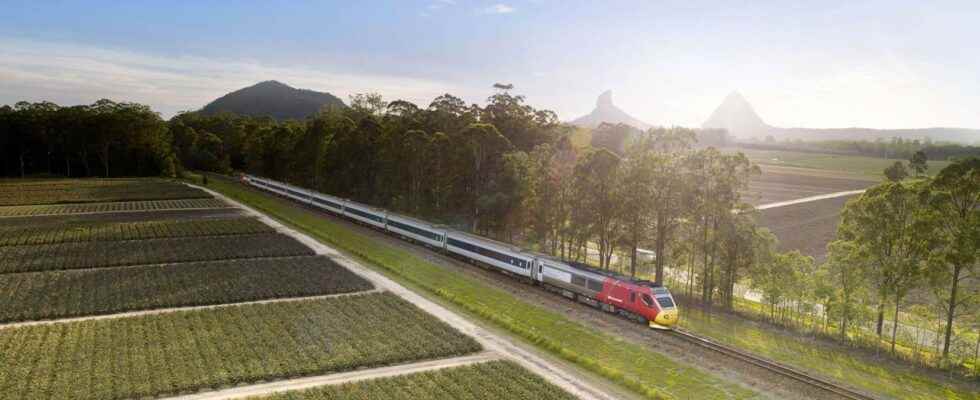This text is part of the special book Plaisirs
The project ? Fool around with Nemo in the largest and most extraordinary marine garden in the world while criss-crossing the outback of the far north-east of Australia. By car !
At Brisbane Rail Station, the Spirit of Queensland looks great in its silver livery. His destination? Cairns, Australia’s northernmost city. He will reach it in 25 hours after covering 1,700 kilometres, the distance separating Montreal from Kangiqsujuaq, in Nunavik!
It’s a departure. On the quay, the staff waves to us. It feels like Japan. Our car looks like a Business class airplane cabin, equipped with RailBeds, shell seats equipped with an entertainment system. Soon, we will be served supper, before transforming our armchairs into berths and informing us of the existence of showers on board. From then on, we will believe we are in first class!
“Well, why take the train? you ask. Quite simply because several of the cities along its route make it easy to reach the Great Barrier Reef (GBC), our real destination, then, for those who want to see the country without driving (on the left, in addition), that’s it Well.
Listed as a UNESCO World Heritage Site, the GBC stretches over 2000 kilometers along the coast of the State of Queensland, between Bundaberg and Cape York in the far north. Made up of 900 islands and 2,500 distinct reefs, it forms a quilt of 350,000 km2 where 400 species of coral live as well as thousands of species of fish and molluscs.
Throughout this unique ecosystem in the world, which attracted an average of 1.3 million tourists annually during the five years preceding the pandemic, scuba diving or snorkeling trips, as well as aerial excursions, allow you to admire all the diversity. Thus, at the end of our night aboard the Spiritwe will descend at Proserpine, halfway through the journey, to explore, from Airlie Beach, one of the most spectacular access points to the GBC: the Whitsunday archipelago.
Moiré mosaic and coral lace
Part of the Great Barrier Reef Marine Park, this archipelago is made up of 74 wooded islands, including Whitehaven and its Whitehaven Beach. Covered with sparkling sand composed of 98% silica, this beach is rightly considered one of the most beautiful on the planet. It is this mineral, the same as in the Icelandic Blue Lagoon, which gives the water its unreal turquoise blue.
Appreciated by sailing enthusiasts, as it is protected from the breaking waves by the GBC, the archipelago is also frequented by divers. “It’s a special type of diving that we practice here,” says instructor Jamie Wilson of Ocean Dynamics. This part of the reef is famous for its soft corals and the color of the water, but due to the high tide and the ensuing mixing of the sediments, visibility is often barely three to four meters! This adds an extra thrill to the underwater adventure… The thrill will however be at its height when flying over the Coral Sea in a helicopter, we will see a heart-shaped reef, manta rays and the fine embroidery that make up, at the water’s edge, the coral flats!
Playing Bali in the film ticket to paradise, which just opened and stars Julia Roberts and George Clooney, Hamilton is one of the few Whitsunday islands that welcomes tourists. But we preferred an islet where wallabies frolic on the rocks at night: Hayman. In 1947, an Australian aviation pioneer inaugurated the region’s first hotel here. Today, it can be proud of the InterContinental Hayman Island Resort, which welcomes chic regulars: crested cockatoos!
The Aboriginal “sea country”
Back on board the Spirit Panoramic, we watch herds of cattle pass by, neat little houses, pineapple plantations, banana plantations and seas of sugar cane. From Townsville, the dense green mountains of Queensland’s Wet Tropics, a collection of UNESCO-listed national parks, alternately approach and recede from us. In Gordonvale, the train stops next to a smoking candy, and it smells strongly of good cane juice! In Cairns, mecca for divers, terminus, everyone goes down.
“Cairns is really the best gateway to the GBC, because we’re at the tip of the continental shelf,” says Richard Blanch, divemaster at Reef Magic. The further south you go, the wider the plateau becomes. So it’s easier to reach it from here. »
It is at Moore Reef, 25 kilometers offshore from the city, that Reef Magic has anchored its new pontoon. Relying on solar and wind energy to power its facilities, it gives into eco-diving, and that smiles on us.
Immersed in the peace of this infinite blue, we contemplate napoleons (giant wrasses), mossy clams and turtles. Well, it’s raining myriads of small fish (clowns, horned fish, parrots, trumpets, butterflies), shoaling or playing hide and seek between anemones, starfish, gorgonians and ruffled soft corals.
Stunned by all its splendor, we say to ourselves that the GBC fulfills its promises: here we are in perfect communion with the “sea country” of the Aborigines. A country that turns out to be even more extraordinary than the one dreamed of, than the one told here.
Our journalist was a guest of Tourism and Events Queensland.
This special content was produced by the Special Publications team of the To have to, pertaining to marketing. The drafting of To have to did not take part.
